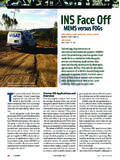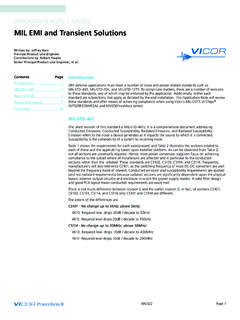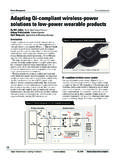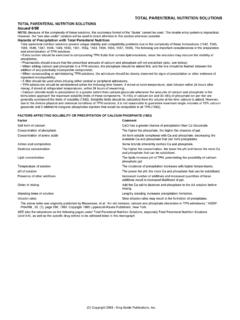Transcription of GNSS Solutions
1 20 InsideGNSS n o v e m b e r / d e c e m b e r 2 0 1 0 gnss Solutions : What is the difference between SNR and C/N0?GPS receivers built for various applications, such as hand-helds, automobiles, mobile phones, and avionics, all have a method for indicating the signal strength of the different satellites they are tracking. Some receivers display the signal strength in the form of verti-cal bars, some in terms of normalized signal strength, and others in terms of carrier-to-noise density (C/N0) or sig-nal-to-noise ratio (SNR). The latter two terms are regularly used so interchangeably that their fundamental differences are often overlooked. A full understanding of the differences between SNR and C/N0 is useful both for users of GPS receiv-ers and for GPS receiver designers and and C/N0 SNR is usually expressed in terms of decibels.
2 It refers to the ratio of the sig-nal power and noise power in a given (dB) = S N (1) S is the signal power, usually the carrier power expressed in units of decibel/milliwatt (dBm) or decibel/watts (dBW); N is the noise power in a given bandwidth in units of dBm or , on the other hand, is usually expressed in decibel-Hertz (dB-Hz) and refers to the ratio of the carrier power and the noise power per unit bandwidth. For the GPS L1 C/A signal, one can consider the received signal power as the power of the original unmodulated carrier power (at the point of reception in a receiver) that has been spread by the spreading (ranging) codes when transmitted from a satellite. We can express C/N0 as follows:C/N0 (dB-Hz) = C (N BW) = C N0 = SNR + BW (2)where C is the carrier power in dBm or dBW; N is the noise power in dBm or dBW; N0 is the noise power density in dBm-Hz or dBW-Hz; BW is the bandwidth of observation, which is usually the noise equivalent bandwidth of the last filter stage in a receiver s RF values in an L1 C/A code receiver are as follows:C/N0: ~ 37 to 45dB-Hz Receiver front-end bandwidth: ~ 4 MHz => BW = 10*log (4,000,000) = 66dB SNR = C/N0 BW => SNR ~ (37 66) to (45 66) => SNR ~ -29dB to -21dBIn order to determine C/N0, then, one clearly needs to determine the carrier power and noise density at the input to the receiver.
3 Noise and Signal PowerThe sources of white noise in a gnss receiver are usually described by the antenna noise temperature and the receiver noise temperature. The anten-na temperature models the noise enter-ing the antenna from the sky whereas the receiver noise temperature models the thermal noise due to the motion of charges within a device such as the GPS receiver front-end. These noise sources specify the noise density, which may be described as follows: N0 (dBw/Hz) = 10*log (k*T), where k is the Boltzmann s constant 10-23 J/K;Measuring gnss Signal Strength anGelo joseph gnss Solutions is a regular column featuring questions and answers about technical aspects of gnss . Readers are invited to send their questions to the columnist, dr. mark Petovello, Department of Geomatics Engineering, University of Calgary, who will find experts to answer them.
4 His e-mail address can be found with his biography at the conclusion of the InsideGNSS n o v e m b e r / d e c e m b e r 2 0 1 0 Solutions T is the noise temperature in degrees on the Kelvin noise density for a typical receiver noise temperature of 290K is -204dBW/Hz or -174 may express the received carrier power asPR = PT L + GR, where PR is the received carrier power; PT is the transmitted carrier power; L is the signal power loss primarily due to path loss; GR is the gain of the receiver s antenna in the direction of the received satellite nominal carrier power received by the receiver is around Hence, for GPS L1 C/A, if one just con-siders thermal noise and the nominal signal power, the nomi-nal C/N0 is given as (-204) = and Noise Paths from Antenna to ReceiverFigure 1 illustrates the stages of a typical GPS RF front-end.
5 Depending on the particular receiver design, some of these components may be situated either inside or outside of the receiver itself. When considering signal and noise paths through the front-end, one needs to consider the noise figure of the vari-ous components in the front-end. The noise figure is given asNF = SNRin / SNRoutand provides an estimate of the amount of noise added by an active component, such as a low-noise amplifier (LNA), or even a passive component, such as a filter or the cable. The noise figure is related to the noise temperature asNF = 10*log(1 + T / To), where T is the noise temperature To is the reference temperature usually well-known Friis formulas can be used to determine the cascaded noise figure or cascaded noise temperature by measuring noise temperatures or noise figures of the indi-vidual components in the receiver front-end.
6 For our discussion, we need only mention that the cas-caded noise figure is primarily dependent on the noise figure and gain of the first LNA in the chain as well as any losses incurred prior to the LNA ( , caused by cables or filtering) because losses incurred after the LNA will be attenuated by the reciprocal of the LNA gain. Band-limiting and quantization schemes chosen within the receiver add additional losses to the received C/N0 is now given as:C/N0 = C/N0 (nominal) NFRX - NFIMP where NFRX is the cascaded noise figure of the receiver; n o v e m b e r / d e c e m b e r 2 0 1 0 InsideGNSS 23 NFIMP represents the losses due to band-limiting and purposes of this discussion, if we assume a cas-caded noise figure of two decibels, then the nominal C/N0 is degraded by two decibels. We can assume an additional noise figure of one decibel due to band-limiting and quantization, which is typical for a two-bit quantized receiver our example, the received nominal C/N0 is given as: C/N0 = 2 - 1 = into consideration the noise environment and the receiver front-end components, the C/N0 of a particular tracked satellite will scale relative to the signal power.
7 The sig-nal power of the various satellites being tracked by the receiv-er will vary in relation to the satellite elevation angle due to differences in path loss and the satellite and receiver antennas gain patterns. So, for example, if the signal power varies 4dB of the nominal signal power of , the corresponding C/N0 will vary from to Interpretation and Significance of C/N0 From our discussions thus far, the C/N0 output by a receiver clearly provides an indication of the signal power of the tracked satellite and the noise density as seen by the receiver s front-end. Two different GPS receivers connected to the same anten-na and tracking the same GPS satellite at the same time may output different C/N0 values. If one assumes that the C/N0 values are computed accurately by both the receivers, the dif-ferences in the C/N0 values can be attributed to differences in the noise figure of the two front-ends and/or the receivers respective band-limiting and quantization schemes.
8 The C/N0 value provides an indication of the signal qual-ity that is independent of the acquisition and tracking algo-rithms used by a receiver. In contrast to SNR, C/N0 is also independent of the receiver s front-end bandwidth and can be readily used to indicate the quality of the received signal. (C/N0 is bandwidth-independent from the noise perspective but bandwidth-dependent if one considers the correlation losses associated with bandlimiting. However, the latter losses are usually within the error uncertainty of C/N0 computation algorithm itself; so, for most practical purposes we can say that C/N0 is bandwidth-independent.)For a given satellite signal and receiver front-end, the C/N0 value may also vary due to set up and installation con-siderations. For example, the use of a long cable before the first LNA stage of the receiver will affect the noise figure and, consequently, the C/N0.
9 However, the C/N0 remains constant through the different signal processing stages of the receiver, such as pre-detection, acquisition, and Acquisition, Processing Blocks, and SNRThe signal-to-noise ratio is most useful when considered 24 InsideGNSS n o v e m b e r / d e c e m b e r 2 0 1 0 the baseband processing blocks of a gnss receiver. In dealing with SNR, the bandwidth of interest needs to be specified. Typically the noise equivalent bandwidth is used, which is defined as the bandwidth of an ideal ( , brick-wall) filter whose bandwidth when multiplied by the white noise density of N0/2 will result in the total noise power at the output of the origi-nal filter. As an example, the transfer func-tion of the integrate and dump filters that are used in GPS signal processing is given by: H(f) = sin( * f*T) / * f*T, where f is the frequency error in the acquisition or tracking block; T is the integration total noise power passed through the filter H(f) is given by However, the noise power passed by an ideal filter is the product of N0/2 and bandwidth ( , BW in Equation 2).
10 As such, the integral in the preceding equation is actually the noise equiva-lent bandwidth of the filter. For the integrate and dump filter the integral evaluates to 1/T. The noise equivalent bandwidth allows one to go back and forth between C/N0 and SNR as per Equation typical GPS receiver implement-ed using either hardware correlators or a software-based approach needs to acquire and track the satellite signal before pseudoranges and carrier phase measurements can be made. Figure 2 presents the typical stages in the receiver s baseband processing. The integration times indicated in the different blocks of the figure refer to the integration or accumulation time of the integrate and dump filters. For illustrative purposes, we chose the following integration times: 1 mil-lisecond for acquisition, 1 millisecond for synchronization with the naviga-tion symbols, 5 milliseconds for com-pleting the frequency lock loop (FLL), and 20 milliseconds for the phase lock loop (PLL).






